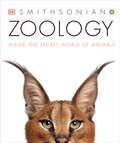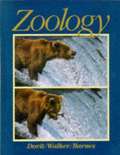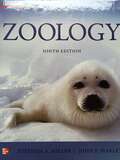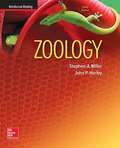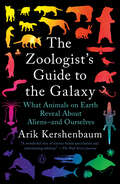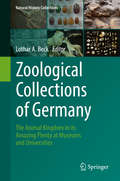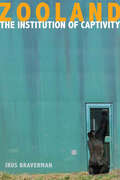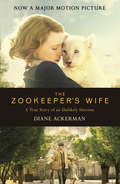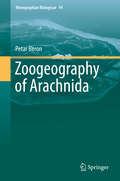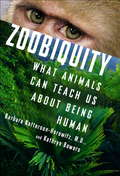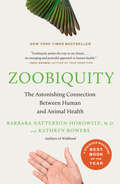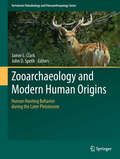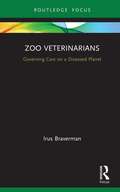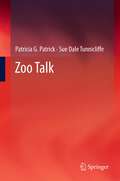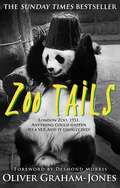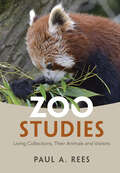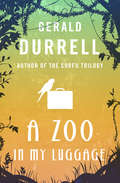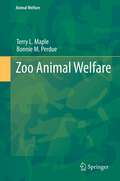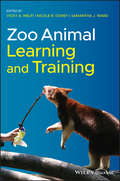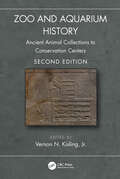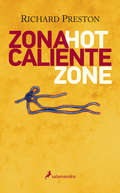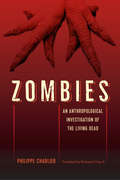- Table View
- List View
Zoology: Inside the Secret World of Animals (DK Secret World Encyclopedias)
by DKSee the animal kingdom in all its glory, from jellyfish to polar bears, with up-close details of their unique features from head to toe. Filled with magnificent photographs that were specially commissioned for this book and cannot be seen anywhere else. Written in association with the Smithsonian Institution.This visual reference book starts with the question "what is an animal?" and takes you through the animal kingdom - mammals, reptiles, birds, and sea creatures. It uses a unique head-to-toe approach that showcases in spectacular detail special features like the flight feathers of a parrot, the antenna of a moth, or the tentacles of coral.This visual encyclopedia is filled with clear and fascinating information on everything about the social lives of animals. Read exciting stories like how animals communicate, defend their territories, and attract mates.Learn how evolution has helped wildlife to adapt to their unique environments, whether it's the ability to live in difficult habitats, adjust to specific diets, or how they work physically.Humans have drawn and painted animals for thousands of years. Zoology has included some of these, like early rock art that depicts our awe of the animal kingdom or natural history artworks like those commissioned by the Mughal Courts in the 1600s.Dramatic Wildlife PhotographySpectacular, never-before-seen photographs that will bring you close to many of the world's most captivating and intriguing inhabitants. This book offers an extraordinary introduction to the animal world by taking you through chapters that details their diversity.Go from head to toe in Zoology: The animal kingdomShape and sizeSkeletons Skins, coats, and armorSensesMouth and jawsLegs, arms, tentacles, and tailsFins, flippers, and paddlesWings and parachutesEggs and offspring
Zoology
by Robert Dorit Warren F. Walker Robert D. BarnesComprehensive, flexible and accessible, the text emphasizes evolution is at the very beginning in discussions of molecular and cell biology. A systems/classification organization and emphasis on "predictive value" reinforce the evolutionary theme.
Zoology
by Stephen A. Miller John P. HarleyThe new 7th edition of "Zoology" continues to offer students an introductory general zoology text that is manageable in size and adaptable to a variety of course formats. It is a principles-oriented text written for the non-majors or the combined course, presented at the freshman and sophomore level. "Zoology" is organized into three parts. Part One covers the common life processes, including cell and tissue structure and function, the genetic basis of evolution, and the evolutionary and ecological principles that unify all life. Part Two is the survey of protists and animals, emphasizing evolutionary and ecological relationships, aspects of animal organization that unite major animal phyla, and animal adaptations. Part Three covers animal form and function using a comparative approach. This approach includes descriptions and full-color artwork that depict evolutionary changes in the structure and function of selected organ systems.
Zoology
by Stephen A. Miller John P. HarleyThe new 7th edition of "Zoology" continues to offer students an introductory general zoology text that is manageable in size and adaptable to a variety of course formats. It is a principles-oriented text written for the non-majors or the combined course, presented at the freshman and sophomore level. "Zoology" is organized into three parts. Part One covers the common life processes, including cell and tissue structure and function, the genetic basis of evolution, and the evolutionary and ecological principles that unify all life. Part Two is the survey of protists and animals, emphasizing evolutionary and ecological relationships, aspects of animal organization that unite major animal phyla, and animal adaptations. Part Three covers animal form and function using a comparative approach. This approach includes descriptions and full-color artwork that depict evolutionary changes in the structure and function of selected organ systems.
The Zoologist's Guide to the Galaxy: What Animals on Earth Reveal About Aliens--and Ourselves
by Arik KershenbaumFrom a noted Cambridge zoologist, a wildly fun and scientifically sound exploration of what alien life must be like, using universal laws that govern life on Earth and in space.Scientists are confident that life exists elsewhere in the universe. Yet rather than taking a realistic approach to what aliens might be like, we imagine that life on other planets is the stuff of science fiction. The time has come to abandon our fantasies of space invaders and movie monsters and place our expectations on solid scientific footing.But short of aliens landing in New York City, how do we know what they are like? Using his own expert understanding of life on Earth and Darwin's theory of evolution--which applies throughout the universe--Cambridge zoologist Dr. Arik Kershenbaum explains what alien life must be like: how these creatures will move, socialize, and communicate. For example, by observing fish whose electrical pulses indicate social status, we can see that other planets might allow for communication by electricity. As there was evolutionary pressure to wriggle along a sea floor, Earthling animals tend to have left/right symmetry; on planets where creatures evolved in midair or in soupy tar, they might be lacking any symmetry at all.Might there be an alien planet with supersonic animals? A moon where creatures have a language composed of smells? Will aliens scream with fear, act honestly, or have technology? The Zoologist's Guide to the Galaxy answers these questions using the latest science to tell the story of how life really works, on Earth and in space.
Zoological Collections of Germany: The Animal Kingdom in its Amazing Plenty at Museums and Universities
by Lothar A. BeckProvides a timely compilation of German zoological collections.<P><P> Casts new light on endangered zoological collections and explores modern exhibition concepts.<P> Maximizes readers insight into the zoological collection network.<P> This book is devoted to the knowledge of up to 250 years of collecting, organizing and preserving animals by generations of scientists. Zoological Collections are a huge resource for modern animal research and should be available for national and international scientists and institutions, as well as prospective public and private customers. Moreover, these collections are an important part of the scientific enterprise, supporting scientific research, human health, public education, and the conservation of biodiversity. Much of what we are beginning to understand about our world, we owe to the collection, preservation, and ongoing study of natural specimens. Properly preserved collections of marine or terrestrial animals are libraries of Earth's history and vital to our ability to learn about our place in its future.<P> The approach employed by the editor involves not only an introduction to the topic, but also an external view on German collections including an assessment of their value in the international and national context, and information on the international and national collection networks. Particular attention is given to new approaches of sorting, preserving and researching in Zoological Collections as well as their neglect and/or threat. In addition, the book provides information on all big Public Research Museums, on important Collections in regional Country and local District Museums, and also on University collections.<P> This is a highly informative and carefully presented book, providing scientific insight for readers with an interest in biodiversity, taxonomy, or evolution, as well as natural history collections at larg
Zooland: The Institution of Captivity
by Irus BravermanThis book takes a unique stance on a controversial topic: zoos. Zoos have their ardent supporters and their vocal detractors. And while we all have opinions onwhatzoos do, few people considerhowthey do it. Irus Braverman draws on more than seventy interviews conducted with zoo managers and administrators, as well as animal activists, to offer a glimpse into the otherwise unknown complexities of zooland. Zoolandbegins and ends with the story of Timmy, the oldest male gorilla in North America, to illustrate the dramatic transformations of zoos since the 1970s. Over these decades, modern zoos have transformed themselves from places created largely for entertainment to globally connected institutions that emphasize care through conservation and education. Zoos naturalize their spaces, classify their animals, and produce spectacular experiences for their human visitors. Zoos name, register, track, and allocate their animals in global databases. Zoos both abide by and create laws and industry standards that govern their captive animals. Finally, zoos intensely govern the reproduction of captive animals, carefully calculating the life and death of these animals, deciding which of them will be sustained and which will expire. Zoolandtakes readers behind the exhibits into the world of zoo animals and their caretakers. And in so doing, it turns its gaze back on us to make surprising interconnections between our understandings of the human and the nonhuman.
The Zookeeper's Wife: An unforgettable true story, now a major film (Movie Tie-in Editions Ser. #0)
by Diane AckermanIn war-torn Warsaw, a zookeeper and his wife refuse to surrender... Now a major motion picture starring Jessica Chastain and Daniel Brühl, Diane Ackerman's The Zookeeper's Wife is based on a remarkable true story of bravery and sanctuary during World War II. Perfect for fans of Lion and Hidden Figures. 'I can't imagine a better story or storyteller. The Zookeeper's Wife will touch every nerve you have' -Jonathan Safran Foer, author of Everything is Illuminated When Germany invades Poland, Luftwaffe bombers devastate Warsaw and the city's zoo along with it. With most of their animals killed, or stolen away to Berlin, zookeepers Jan and Antonina Zabinski begin smuggling Jews into the empty cages.As the war escalates Jan becomes increasingly involved in the anti-Nazi resistance. Ammunition is buried in the elephant enclosure and explosives stored in the animal hospital. Plans are prepared for what will become the Warsaw uprising. Through the ever-present fear of discovery, Antonina must keep her unusual household afloat, caring for both its human and animal inhabitants - otters, a badger, hyena pups, lynxes - as Europe crumbles around them.Written with the narrative drive and emotional punch of a novel, The Zookeeper's Wife is a remarkable true story. It shows us the human and personal impact of war - of life in the Warsaw Ghetto, of fighting in the anti-Nazi resistance. But more than anything it is a story of decency and sacrifice triumphing over terror and oppression. What readers are saying about The Zookeeper's Wife: 'Beautifully and sensitively written - a must read''An adventure that inspires''Both horrifying and endearing on a scale I've not experienced in years''A story that will haunt you forever''Haunting, life affirming, sad, and inspiring'
Zoogeography of Arachnida (Monographiae Biologicae #94)
by Petar BeronThis volume merges all geographical and paleogeographical data on all groups of the arachnofauna. The book features topics such as the ecological factors, climate and other barriers that influence the distribution of arachnida. It also elaborates on the characteristics of the distribution such as arachnida at high altitude (e.g. Himalaya), in caves, in polar regions and highlights differences between the arachnofauna of e.g. Mediterranean regions vs Central Europe, West African vs Indomalayan and more. Furthermore, amongst other topics the volume also includes chapters on the systems of arachnida, fossil orders, dispersal and dispersion, endemics and relicts, regional arachnogeography, cave and high altitude arachnida.
Zoobiquity
by Kathryn Bowers Barbara N. HorowitzEngaging science writing that bravely approaches a new frontier in medical science and offers a whole new way of looking at the deep kinship between animals and human beings. Zoobiquity: a species-spanning approach to medicine bringing doctors and veterinarians together to improve the health of all species and their habitats. In the tradition of Temple Grandin, Oliver Sacks, and Neil Shubin, this is a remarkable narrative science book arguing that animal and human commonality can be used to diagnose, treat, and ultimately heal human patients. Through case studies of various species--human and animal kind alike--the authors reveal that a cross-species approach to medicine makes us not only better able to treat psychological and medical conditions but helps us understand our deep connection to other species with whom we share much more than just a planet. This revelatory book reaches across many disciplines--evolution, anthropology, sociology, biology, cutting-edge medicine and zoology--providing fascinating insights into the connection between animals and humans and what animals can teach us about the human body and mind.
Zoobiquity: What Animals Can Teach Us About Health and the Science of Healing
by Kathryn Bowers Barbara Natterson-HorowitzIn the spring of 2005, cardiologist Barbara Natterson-Horowitz was called to consult on an unusual patient: an Emperor tamarin at the Los Angeles Zoo. While examining the tiny monkey's sick heart, she learned that wild animals can die of a form of cardiac arrest brought on by extreme emotional stress. It was a syndrome identical to a human condition but one that veterinarians called by a different name--and treated in innovative ways. This remarkable medical parallel launched Natterson-Horowitz on a journey of discovery that reshaped her entire approach to medicine. She began to search for other connections between the human and animal worlds: Do animals get breast cancer, anxiety-induced fainting spells, sexually transmitted diseases? Do they suffer from obsessive-compulsive disorder, bulimia, addiction? The answers were astonishing. Dinosaurs suffered from brain cancer. Koalas catch chlamydia. Reindeer seek narcotic escape in hallucinogenic mushrooms. Stallions self-mutilate. Gorillas experience clinical depression. Joining forces with science journalist Kathryn Bowers, Natterson-Horowitz employs fascinating case studies and meticulous scholarship to present a revelatory understanding of what animals can teach us about the human body and mind. "Zoobiquity" is the term the authors have coined to refer to a new, species-spanning approach to health. Delving into evolution, anthropology, sociology, biology, veterinary science, and zoology, they break down the walls between disciplines, redefining the boundaries of medicine. Zoobiquity explores how animal and human commonality can be used to diagnose, treat, and heal patients of all species. Both authoritative and accessible, offering cutting-edge research through captivating narratives, this provocative book encourages us to see our essential connection to all living beings.
Zooarchaeology and Modern Human Origins: Human Hunting Behavior during the Later Pleistocene
by Jamie L. Clark John D. SpethRecent genetic data showing that Neanderthals interbred with modern humans have made it clear that deeper insight into the behavioral differences between these populations will be critical to understanding the rapid spread of modern humans and the demise of the Neanderthals. This volume, which brings together scholars who have worked with faunal assemblages from Europe, the Near East, and Africa, makes an important contribution to our broader understanding of Neanderthal extinction and modern human origins through its focus on variability in human hunting behavior between 70-25,000 years ago--a critical period in the later evolution of our species.
Zooarchaeology
by Elizabeth J. Reitz Elizabeth S. WingThis book includes new sections on enamel ultra structure and incremental analysis, stable isotopes and trace elements, ancient genetics and enzymes, environmental reconstruction, people as agents of environmental change etc.
Zoo Veterinarians: Governing Care on a Diseased Planet (Law, Science and Society)
by Irus BravermanDespite their centrality to the operation of contemporary accredited zoo and aquarium institutions, the work of zoo veterinarians has rarely, if ever, been the focus of a critical analysis in the social science and humanities. Drawing on in-depth interviews and observations of zoo and aquarium veterinarians in Europe and North America, this book highlights the recent transformation that has occurred in the zoo veterinarian profession during a time of ecological crisis, and what these changes can teach us about our rapidly changing planet. Zoo vets, Braverman instructs us with a wink, have "gone wild." Originally an individual welfare-centered profession, these experts are increasingly concerned with the sustainability of wild animal populations and with ecological health. In this sense, the story of zoo vets "going wild"—in their subjects of care, their motivations, and their ethical standards, as well as in their professional practices and scientific techniques—is also a story about zoo animals gone wild, wild animals encroaching the zoo, and, more generally, a wild world that is becoming "zoo-ified." Such transformations have challenged existing norms of veterinary practice. Exploring the regulatory landscape that governs the work of zoo and aquarium veterinarians, Braverman traverses the gap between the hard and soft sciences and between humans and nonhumans. At the intersection of animal studies, socio-legal studies, and Science and Technology Studies, this book will appeal not only to those interested in zoos and in animal welfare, but also to scholars in the posthumanities.
Zoo Talk
by Sue Dale Tunnicliffe Patricia G. PatrickFounded on the premise that zoos are 'bilingual'--that the zoo, in the shape of its staff and exhibits, and its visitors speak distinct languages--this enlightening analysis of the informal learning that occurs in zoos examines the 'speech' of exhibits and staff as well as the discourse of visitors beginning in the earliest years. Using real-life conversations among visitors as a basis for discussion, the authors interrogate children's responses to the exhibits and by doing so develop an 'informal learning model' and a 'zoo knowledge model' that prompts suggestions for activities that classroom educators can use before, during, and after a zoo visit. Their analysis of the 'visitor voice' informs creative suggestions for how to enhance the educational experiences of young patrons. By assessing visitors' entry knowledge and their interpretations of the exhibits, the authors establish a baseline for zoos that helps them to refine their communication with visitors, for example in expanding knowledge of issues concerning biodiversity and biological conservation. The book includes practical advice for zoo and classroom educators about positive ways to prepare for zoo visits, engaging activities during visits, and follow-up work that maximizes the pedagogical benefits. It also reflects on the interplay between the developing role of zoos as facilitators of learning, and the ways in which zoos help visitors assimilate the knowledge on offer. In addition to being essential reading for educators in zoos and in the classroom, this volume is full of insights with much broader contextual relevance for getting the most out of museum visits and field trips in general.
Zoo Tails
by Oliver Graham JonesOne puff adder, one antelope, one crocodile – This was the list of sick animals presented to Oliver Graham-Jones on his first day as a new vet at London Zoo in 1951. And his time at the zoo didn’t get any less strange or entertaining…There’s the time he anaesthetized, and was then chased by, a gorilla; had to capture an angry polar bear in thick fog; performed a colostomy on a python; and fitted a raven in the Tower of London with a wooden leg. And if an animal escaped (more frequently than you might think) or required urgent medical attention, he was always on hand, ready for any eventuality. With his self-deprecating humour, Oliver frequently described himself as quaking with fear, but he was also skilful, brave and, most of all, incredibly caring and kind to his animal patients.
Zoo Studies: Living Collections, Their Animals and Visitors
by Paul A. ReesZoos and aquariums are culturally and historically important places where families enjoy their leisure time and scientists study exotic animals. Many contain buildings of great architectural merit. Some people consider zoos little more than animal prisons, while others believe they play an important role in conservation and education. Zoos have been the subject of a vast number of academic studies, whose results are scattered throughout the literature. This interdisciplinary volume brings together research on animal behaviour, visitor studies, zoo history, human-animal relationships, veterinary medicine, welfare, education, enclosure design, reproduction, legislation, and zoo management conducted at around 200 institutions located throughout the world. The book is neither 'pro-' nor 'anti-' zoo and attempts to strike a balance between praising zoos for the good work they have done in the conservation of some species, while recognising that they face many challenges in making themselves relevant in the modern world.
Zoo in the Sky: A Book of Animal Constellations
by Jacqueline MittonLittle Bear and the Great Bear in the Northern Sky; the scaly dragon winding his long tail; the Great Dog chasing the Hare in the Southern Sky; all are beautifully rendered in Christina Balit's vibrant art, studded with shiny stars, which perfectly illustrates Jacqueline Mitton's rich text.
A Zoo in My Luggage: A Zoo In My Luggage, The Whispering Land, And Menagerie Manor (The Zoo Memoirs #1)
by Gerald DurrellWhat happens when the charming, animal-obsessed boy of the classic memoirs 'My Family and Other Animals' and 'Birds, Beasts and Other Relatives' grows up? He founds a zoo, of course.
Zoo Animal Welfare
by Terry Maple Bonnie M PerdueZoo Animal Welfare thoroughly reviews the scientific literature on the welfare of zoo and aquarium animals. Maple and Perdue draw from the senior author's 24 years of experience as a zoo executive and international leader in the field of zoo biology. The authors' academic training in the interdisciplinary field of psychobiology provides a unique perspective for evaluating the ethics, practices, and standards of modern zoos and aquariums. The book offers a blueprint for the implementation of welfare measures and an objective rationale for their widespread use. Recognizing the great potential of zoos, the authors have written an inspirational book to guide the strategic vision of superior, welfare-oriented institutions. The authors speak directly to caretakers working on the front lines of zoo management, and to the decision-makers responsible for elevating the priority of animal welfare in their respective zoo. In great detail, Maple and Perdue demonstrate how zoos and aquariums can be designed to achieve optimal standards of welfare and wellness.
Zoo Animal Learning and Training
by Vicky A. Melfi Nicole R. Dorey Samantha J. WardComprehensively explains animal learning theories and current best practices in animal training within zoos This accessible, up-to-date book on animal training in a zoo/aquaria context provides a unified approach to zoo animal learning, bringing together the art and science of animal training. Written by experts in academia and working zoos, it incorporates the latest information from the scientific community along with current best practice, demystifying the complexities of training zoo animals. In doing so, it teaches readers how to effectively train animals and to fully understand the consequences of their actions. Zoo Animal Learning and Training starts with an overview of animal learning theory. It describes the main categories of animal learning styles; considers the diverse natural history of zoo animals; reviews the research undertaken which demonstrates ultimate benefits of learning; and highlights the advantages and disadvantages of the different approaches. It also shows how the direct application of learning theory can be integrated into zoo animal management; discusses how other factors might affect development; and investigates situations and activities from which animals learn. It also explores the theoretical basis that determines whether enrichments are successful. Provides an easily accessibly, jargon-free introduction to the subject Explores different training styles, providing theoretical background to animal learning theory as well as considerations for practical training programme – including how to set them up, manage people and animals within them and their consequences Includes effective skills and ‘rules of thumb’ from professional animal trainers Offers commentary on the ethical and welfare implications of training in zoos Features contributions from global experts in academia and the zoo profession Uniquely features both academic and professional perspectives Zoo Animal Learning and Training is an important book for students, academics and professionals. Suited to senior undergraduate students in zoo biology, veterinary science, and psychology, and for post-graduate students in animal management, behaviour and conservation, as well as zoo biology. It is also beneficial to those working professionally in zoos and aquaria at different levels.
Zoo and Aquarium History: Ancient Animal Collections to Conservation Centers
by Vernon N. Kisling Jr.Wild animals have been housed in zoos and aquariums for 5,000 years, fascinating people living in virtually every society. Today, these institutions are at a new milestone in their history. This second edition of Zoo and Aquarium History takes the reader on a journey through the transition of private collections to menageries, to zoos, then zoological gardens, and more recently conservation centers and sanctuaries. Under the direction of Vernon N. Kisling, an expert in zoo history, an international team of authors has thoroughly updated the only comprehensive, global history of animal collections, menageries, zoos, and aquariums. The resulting book documents the continuum of efforts in maintaining wild animal collections from ancient civilizations through today, explaining how modern zoos have developed their mission statements around the core aims of conservation, education, research and recreation. This new edition pulls together regional information, including new chapters on zoological gardens of Canada, Latin America, China, Israel, the Middle East, and New Zealand, along with the cultural aspects of each region to provide a foundation upon which further research can be based. It presents a chronological listing of the world's zoos and aquariums and features many never-before published photographs. Sidebars present supplementary information on pertinent personalities, events, and wildlife conservation issues. The original Appendix has been expanded to include over 1,200 zoos and aquariums, providing an invaluable resource. This is an extensive, chronological introduction to the subject, highlighting the published and archival resources for those who want to know more.
Zona caliente
by Richard PrestonLa historia del brote de Ébola más mortífero en la historia: un relato apasionante de los médicos y científicos que lucharon, y luchan, por protegernos. Zona caliente: área del laboratorio denominada así por los científicos que investigan los virus más letales como el ébola. Sellada herméticamente, sus accesos están rigurosamente controlados y los operarios visten trajes especiales sometidos a duchas de desinfección antes de abandonar el recinto. Parte de los hechos narrados en este libro transcurren en una «zona caliente» gestionada por el Ejército de Estados Unidos en Maryland. Zona caliente fue escrito y publicado en 1994 para explicar los orígenes y la evolución del virus ébola y advertir del peligro de su propagación en el futuro. Su autor, Richard Preston, catedrático de la Universidad de Princeton y un destacado especialista en abordar temas científicos con un alto nivel de rigor y conocimiento de la materia -ha sido galardonado con el Premio del Instituto de Física de Estados Unidos y Zona caliente es lectura recomendada en los institutos de Norteamérica-, fue el primero en dar a conocer al gran público la amenaza del ébola, un virus potencialmente mil veces más letal que el VIH del sida y que, hasta el día de hoy, no ha sido controlado en su totalidad. La narración de esta historia, que se lee como una novela, se basa en hechos reales documentados con precisión y contrastados hasta el límite de lo posible. El resultado es un relato apasionante y esclarecedor, una fuente rica en datos fidedignos sobre todos los aspectos involucrados en este desafío de la naturaleza. Así, los lectores podrán formarse una opinión razonada por encima de todo el torrente de informaciones fragmentadas que propician en la opinión pública una sensación de desconcierto y temor.
Zombies: An Anthropological Investigation of the Living Dead
by Philippe Charlier“A compelling account of the zombi as an anthropological reality and evocative symbol of a state of dispossession, desperation, and death.”—Roger Luckhurst, author of Zombies: A Cultural History “An adventurer’s anthropological quest offering a novel description of the contemporary zombie.”—Sarah J. Lauro, author of The Transatlantic Zombie: Slavery, Rebellion, and Living Death “Displays an empathy for the cultural reality of the zombie in Haiti that delivers important insight on the island nation’s people and their lived realities.”—Christopher M. Moreman, coeditor of Race, Oppression and the Zombie: Essays on Cross-Cultural Appropriations of the Caribbean Tradition Forensic pathologist Philippe Charlier—dubbed the “Indiana Jones of the graveyards”—travels to Haiti where rumors claim that some who die may return to life as zombies. Charlier investigates these far-fetched stories and finds that, in Haiti, the dead are a part of daily life. Families, fearing that loved ones may return from the grave, urge pallbearers to take rambling routes to prevent the recently departed from finding their way home from cemeteries. Corpses are sometimes killed a second time…just to be safe. And a person might spend their life preparing their funeral and grave to ensure they will not become a wandering soul after death. But are the stories true? Charlier’s investigations lead him to Vodou leader Max Beauvoir and other priests, who reveal how bodies can be reanimated. In some cases, sorcerers lure the dead from their graves and give them a potion concocted from Devil’s Snare, a plant more commonly known as Jimsonweed. Sometimes secret societies use poudre zombi—“zombie powder”—spiked with the tetrodotoxin found in blowfish. Charlier eagerly collects evidence, examining Vodou dolls by X-ray, making sacrifices at rituals, and visiting cemeteries under the cloak of night. Zombies follows Charlier’s journey to understand the fascinating and frightening world of Haiti’s living dead, inviting readers to believe the unbelievable.
